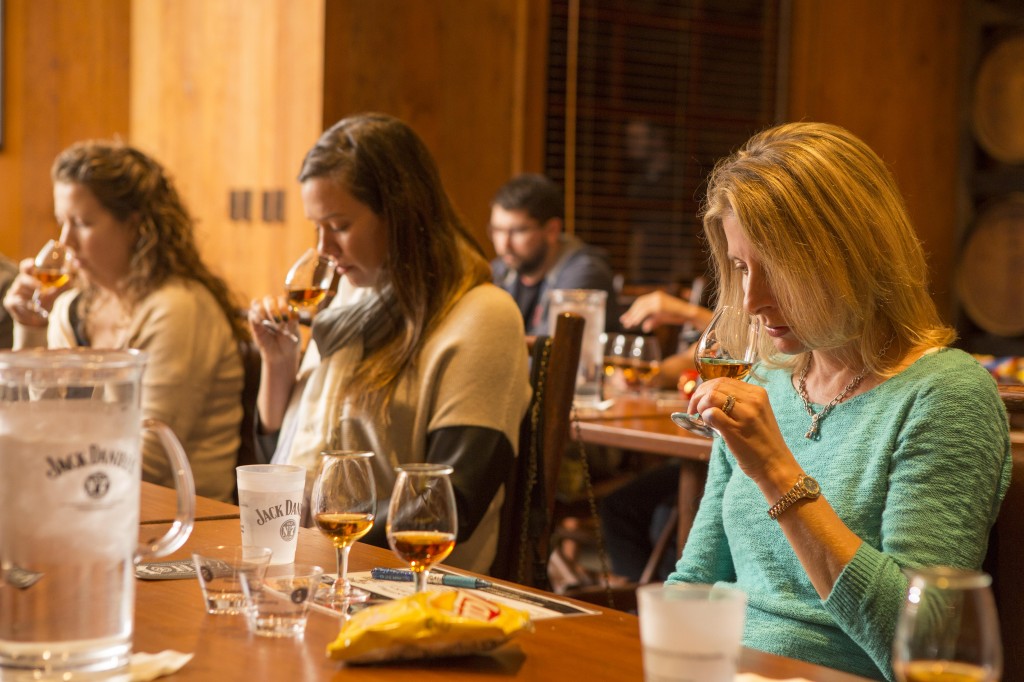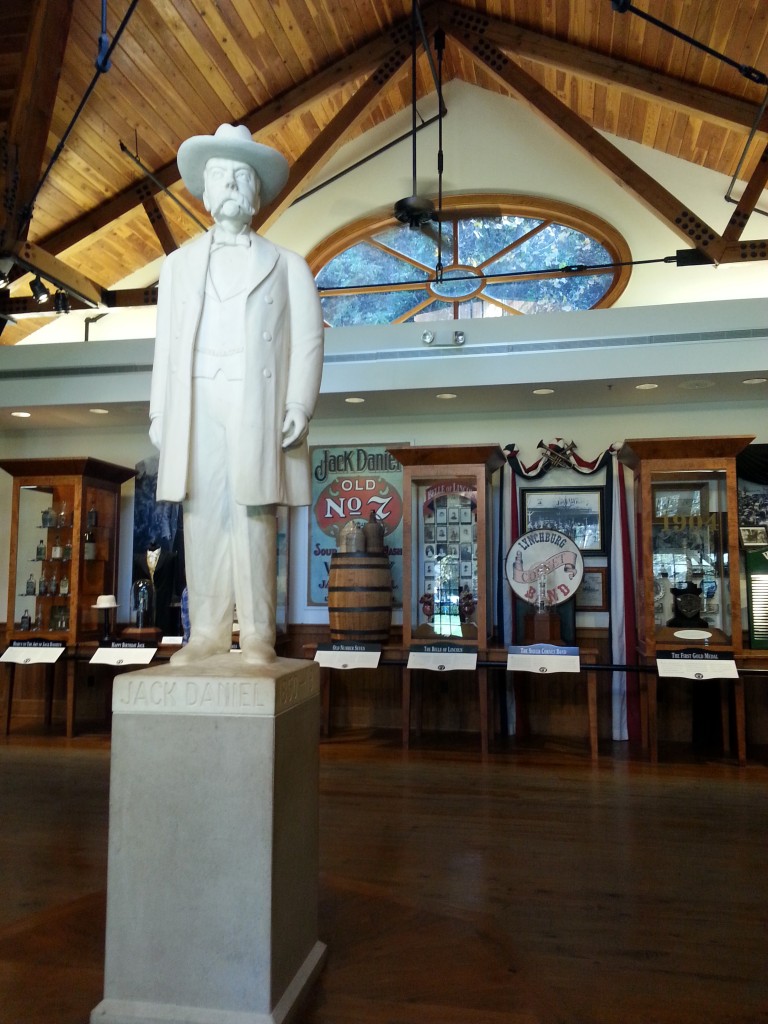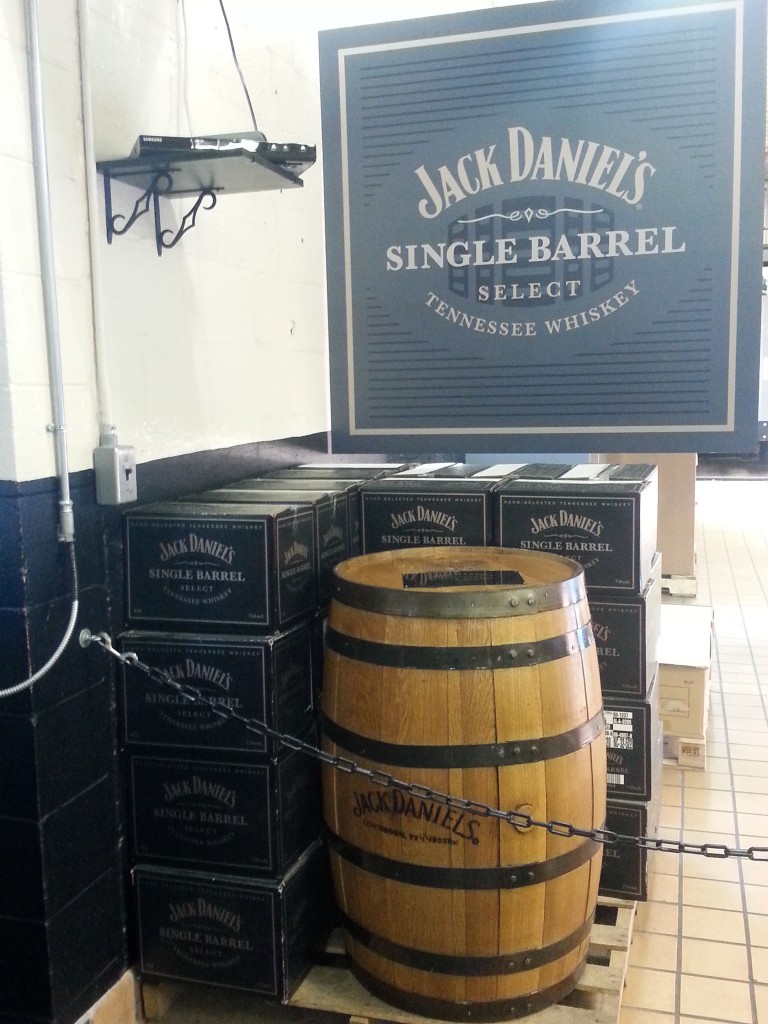The author gets schooled in all things Tennessee whiskey at “Camp Jack.”
By Kelly A. Magyarics
Recently I was invited to attend Camp Jack in Lynchburg, Tennessee. Usually reserved for Jack Daniel’s marketing and sales employees, Camp Jack gives attendees a sneak peek at what happens before the celebrated whiskey is packaged in that iconic black label-adorned squared-off bottle. For this session, the distillery opened it up to the media, so eight writers and whiskey lovers (including myself) spent two full days learning everything from the importance of charcoal and spring water to the finished product, to how tricky it can be to put on those labels by hand.

The inaugural media class at Camp Jack. Photo courtesy of @EdRode.
We were fortunate to spend a lot of time with Master Distiller Jeff Arnett, who is only the seventh employee to hold that title since the distillery was founded. He led us through a guided tasting of the portfolio including barrel samples of their not-yet-released rye that’s ageing in the warehouses. We also listened to factoids, stories (and maybe a tall tale or two) from Jack Daniel’s Historian Nelson Eddy, a wealth of knowledge and a fun drinking buddy. I left Lynchburg with new-found knowledge and respect for the world’s best-selling American whiskey, a signed certificate stating that I “graduated” from Camp Jack, and, as all who go through the experience, a new nickname to be used in the Hollow: Kicks. Check out #18 for the story behind that nickname.
What really struck me about Jack Daniel’s is the artisanal vibe that seems to be present, even for a distillery of its size. Here are some other tidbits I gleaned during my stay. See how well you know Jack:
- A slave taught Jack Daniel how to make whiskey. After Jasper Newton Jack Daniel’s mother died when he was 2 and his father remarried, Reverend Dan Call took in young Jack. One of his slaves, named Nearest Green, taught Jack the art of distillation. (During an evening exploring Nashville’s cocktail scene, we sampled Nearest Green’s namesake cocktail at 404 Kitchen. It was created by bartender Travis Brazil, and mixes Jack Daniel’s Single Barrel Tennessee Whiskey with Laird’s Apple Brandy, Benton’s Smoky Mountain Bacon and citrus-infused honey.)

The Nearest Green cocktail at 404 Kitchen in Nashville pays homage to the slave who taught Jack Daniel how to make whiskey.
- The water led Jack Daniel to the Lynchburg area. Pure and cold, it’s also mineral rich, which keeps yeast healthy and iron-free, which assures a fresh, clean final product. It’s also plentiful — a 10 million gallon reservoir doesn’t deplete even during droughts. We sampled the finished product mixed with a splash of that pure spring water — very special.

Tasting Jack Daniel’s mixed with a splash of the spring water from which it’s made. (Photos courtesy of Kelly Magyarics)
- Jack Daniel’s was the official whiskey of the Rat Pack. Frank Sinatra declared onstage how much he loved JD, and he was even buried with a bottle of it. Today the distillery offers Sinatra Select, a $160 bottle that’s aged in barrels with deep grooves in the staves, which render more oak character, and then bottled at a higher 90 proof.

Sinatra Select is named for Ol’ Blue Eyes, who loved Jack Daniel’s. (Photo courtesy of Kelly Magyarics)
- …Leading to a 23-year shortage. Though we tend to think of Jack Daniel’s as ubiquitous, there was a major shortage of Jack Daniel’s Whiskey from 1956 to 1979. It was only available on allocation. Think of that the next time you see fully stocked store or bar shelves.
- All Jack Daniel’s Whiskey is produced onsite at the distillery in Lynchburg and aged nearby. For a distillery of its size (12 million cases annually), it’s quite unusual not to have several distillation sites. There are two million bottles in inventory at any given time, and more than half of all the whiskey they produce is sold internationally in 160 countries. Jack Daniel’s is the top-selling American whiskey in the world.
- It’s produced in a county where it’s illegal to purchase it. Yes, Moore County, the site of the distillery, is a dry county. Fortunately, it’s not illegal to consume alcohol (so you can sip your Jack and Ginger on the porch), but you won’t find any restaurants that sell wine, beer or liquor, nor will you find any bars. Locals told me that they need 2,500 signatures to change the law, which is impossible to attain as there aren’t even that many registered voters. Visitors to the distillery (of which there are 250,000 annually) can purchase small amounts as they are considered “souvenirs.”
- Jack Daniel’s Whiskey is aged in 86 warehouses around the area. Every bottle is aged four to seven years; each day, employees add 3,000 barrels to the warehouses and pull out 2,000-3,000 of aged whiskey ready to be bottled.

- Tennessee whiskey is just like Bourbon, except for the Lincoln County Process. Jack Daniel’s is technically a Straight Bourbon Whiskey produced in Tennessee. (Remember, the definition of Bourbon is a spirit produced anywhere in the U.S. from at least 51 percent corn, aged in new, charred American oak barrels; straight Bourbon is aged for at least two years.) The Lincoln County Process (which the distillery didn’t actually create) takes out bitter notes and makes the whiskey sweeter, all by filtering it through charcoal. Jack Daniel’s spends $1 million per year on sugar maple charcoal, which is burned three days a week, during three batches per day. We had the chance to ignite the wood, using whiskey rather than lighter fluid to prevent any off flavors. Whiskey for this purpose is stored in a bottle marked “Whiskey for Destruction” so it’s not taxed, which we all agreed would be an amazing band name. It takes the whiskey a week to drip through the charcoal, which is 10-feet deep.

Watching the Lincoln County Process in action. (Photo courtesy of Kelly Magyarics)
- The mash bill for Jack Daniel’s is 80 percent corn from the Midwest, 12 percent barley from Montana and 8 percent rye from Canada. This one’s for the true whiskey nerds.
- Employees get a free pint the first Friday of every month. This day is referred to as Good Friday, for obvious reasons. Since the sale of alcohol is illegal in Moore County, this whiskey is often used as a bartering tool for non-imbibing employees (yes, there are people who work for Jack Daniel’s who don’t drink, and in fact a former Master Distiller was also a teetotaler.) I heard a story of employees using it as a down payment on a car.
- Tabasco sauce is aged in used Jack Daniel’s barrels. Since part of the legal definition for Tennessee Whiskey is that it’s aged in “charred, new oak barrels,” the distillery can only use them once. In addition to Tabasco, used ones are also sold to those in the Scotch, sherry and port business, as well as being used for decorative planters, which you can buy at their gift shop in town.
- Jack Daniel’s produces more than Black Label/No. 7. In addition to the aforementioned Sinatra Select, they make Gentleman Jack, which is charcoal mellowed before and after barreling, and is great in cocktails; Single Barrel Whiskey, which comes from the highest, hottest floors of the warehouse, and — as with single vintage wine — can have varied aromas and flavors; cinnamon-tinged Fire and sweet, herbal Honey, which are mainly intended for shots; and Winter Heat, their latest offering, which is similar to a whiskey version of a mulled wine, to be served warm.

Tasting through the Jack Daniel’s portfolio. (Photo courtesy of @EdRode)
- The distillery ceased operations only twice. During Prohibition and World War II. Otherwise it’s been full steam ahead in Lynchburg.
- Sour Mash is an integral part of making TN whiskey. This refers to adding some of the old batch of mash (the fermented “beer” that gets distilled) into a new batch, which drops the pH level and gives the yeast the right environment to work its magic.
- The weekly production statistics are staggering. Jack Daniel’s produces 800,000 gallons of whiskey, uses 9 million pounds of grain, produces 5 million gallons of “beer” and uses 3,500 tons of wood fuel.

This statue of Jack Daniel in the lobby of the distillery is life size…except for the feet. His were so tiny the statue would have fallen over if they were life size. (Photo courtesy of Kelly Magyarics)
- …but the distillery is very green. Less than 1 percent of waste ends up in landfills; each bottle contains 20 percent-30 percent of recycled glass; the plastic wrap used to wrap the cases is recycled and used in Trex composite decking; spent grains are fed to cows after fermentation (the distillery jokes that they “marinate our beef from the inside); used barrels are sold to other producers; and the distillery treats its own wastewater.
- You can purchase an entire barrel of Jack Daniel’s Single Barrel Whiskey. For around $10,000, you get your own barrel of whiskey, which translates to about 240 bottles. You can even keep the empty barrel.

For a mere $10,000, a full barrel of JD Single Barrel can be yours…and it’s actually a good deal. (Photo courtesy of Kelly Magyarics)
- Jack Daniel may have ultimately died from kicking a safe. The story goes that Jack got to work earlier one morning than his business partner, who usually arrived first. When the combination to the safe wasn’t working, he ended up kicking it and broke his toe. He got an infection that eventually led to blood poisoning. During a cocktail completion at Camp Jack, I named my partner’s and my concoction “Don’t Kick the Safe.” Unfortunately we didn’t win, but we are hoping that the hashtag #dontkickthesafe goes viral as a euphemism for “Don’t get all worked up about it.”

Jack Daniel’s grave in Lynchburg, Tennessee. (Photo courtesy of Kelly Magyarics)
Kelly Magyarics, DWS, is a wine, spirits and lifestyle writer, and wine educator, in the Washington, D.C. area. She can be reached through her website, www.kellymagyarics.com, or on Twitter or Instagram @kmagyarics.





